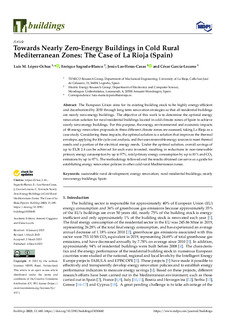| dc.rights.license | Attribution 4.0 International | * |
| dc.contributor.author | Sagredo Blanco, Enrique | |
| dc.contributor.other | López-Ochoa, Luis M. | |
| dc.contributor.other | Las-Heras-Casas, Jesús | |
| dc.contributor.other | García-Lozano, César | |
| dc.date.accessioned | 2024-03-25T13:52:28Z | |
| dc.date.available | 2024-03-25T13:52:28Z | |
| dc.date.issued | 2023 | |
| dc.identifier.issn | 2075-5309 | en |
| dc.identifier.other | https://katalogoa.mondragon.edu/janium-bin/janium_login_opac.pl?find&ficha_no=174681 | en |
| dc.identifier.uri | https://hdl.handle.net/20.500.11984/6313 | |
| dc.description.abstract | The European Union aims for its existing building stock to be highly energy-efficient and decarbonized by 2050 through long-term renovation strategies so that all residential buildings are nearly zero-energy buildings. The objective of this work is to determine the optimal energy renovation solution for rural residential buildings located in cold climate zones of Spain to achieve nearly zero-energy buildings. For this purpose, the energy, environmental and economic impacts of 48 energy renovation proposals in three different climate zones are assessed, taking La Rioja as a case study. Considering these impacts, the optimal solution is a solution that improves the thermal envelope, applying the life cycle cost analysis, and that uses renewable energy sources to meet thermal needs and a portion of the electrical energy needs. Under the optimal solution, overall savings of up to EUR 2.4 can be achieved for each euro invested, resulting in reductions in non-renewable primary energy consumption by up to 97%, total primary energy consumption by up to 81% and CO2 emissions by up to 97%. The methodology followed and the results obtained can serve as a guide for establishing energy renovation policies in other cold rural Mediterranean zones. | en |
| dc.language.iso | eng | en |
| dc.publisher | MDPI | en |
| dc.rights | © 2023 The Authors | en |
| dc.rights.uri | http://creativecommons.org/licenses/by/4.0/ | * |
| dc.subject | sustainable rural development | en |
| dc.subject | energy renovation | en |
| dc.subject | rural residential buildings | en |
| dc.subject | nearly zero-energy buildings | en |
| dc.subject | Spain | en |
| dc.title | Towards Nearly Zero-Energy Buildings in Cold Rural Mediterranean Zones: The Case of La Rioja (Spain) | en |
| dcterms.accessRights | http://purl.org/coar/access_right/c_abf2 | en |
| dcterms.source | Buildings | en |
| local.contributor.group | Almacenamiento de energía | es |
| local.contributor.group | Economía Circular y Sostenibilidad Industrial | es |
| local.contributor.group | Sistemas electrónicos de potencia aplicados al control de la energía eléctrica | es |
| local.description.peerreviewed | true | en |
| local.identifier.doi | https://doi.org/10.3390/buildings13030680 | en |
| local.contributor.otherinstitution | https://ror.org/0553yr311 | |
| local.source.details | Vol. 13. N. 3. N. art. 680, 2024 | |
| oaire.format.mimetype | application/pdf | en |
| oaire.file | $DSPACE\assetstore | en |
| oaire.resourceType | http://purl.org/coar/resource_type/c_6501 | en |
| oaire.version | http://purl.org/coar/version/c_970fb48d4fbd8a85 | en |
| dc.unesco.campo | http://skos.um.es/unesco6/33 | en |
| dc.unesco.disciplina | http://skos.um.es/unesco6/3322 | en |








